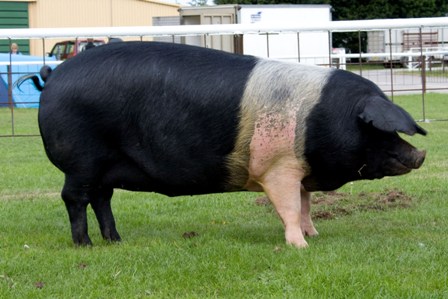Type the name of the breed you're looking for below
[wpdreams_ajaxsearchlite] Don't see the breed your're looking for? Click here and let us know!
British Saddleback pig
| Place of Origin | England |
| Origin | The British Saddleback is a breed of domestic pig created in the 20th century from the amalgamation of two similarly-coloured breeds, the Essex and Wessex Saddleback. The origin of the British Saddleback is better authenticated than most. Lord Western, while travelling in Italy, saw some Neapolitan pigs and came to the conclusion that they were just what he needed to improve the breed of Essex pigs. He procured a pair of Neapolitans and crossed them with Essex sows. One of his tenants Fisher Hobbs of Boxted Lodge availed himself of the opportunity to use the Neapolitan-Essex boars belonging to Lord Western and crossed them with his coarse Essex sows and in process of time established the Improved Essex. Sidney in his last edition of Youatt on the Pig, says “The improved Essex probably date their national reputation from the second show of the Royal Agricultural Society, held at Cambridge, in 1840, when a boar and sow, both bred by Mr Hobbs, each obtained first prizes in their respective classes.” In his 1855 novel Westward Ho!, Charles Kingsley describes one character as a "Fisher Hobbs' pig", and adds: ...and if you do not know, reader, what a Fisher Hobbs is, you know nothing about pigs, and deserve no bacon for breakfast. —Charles Kingsley, Westward Ho!, Chapter VIII |
| Purpose | Meat |
| Characteristics | The Essex pig was mainly found in East Anglia. This pig had a black head and neck, as well as a clearly defined belt of white extending over the shoulders and continuing over the forelegs. The rest of the body was black with the exception of white feet and the tip of the tail. British Saddlebacks are hardy and noted for their mothering ability. The breed continues to be used mainly to provide coloured dams for the production of first-cross porkers, baconers and heavy pigs. The breed is known for its grazing ability and is very hardy. It has secured a niche in outdoor and organic production. Kingsley (supra) describes the breed as "a pig of self-helpful and serene spirit, ..., fatting fast while other pigs' ribs are staring through their skins". The Wessex originated in the New Forest as a cross between two indigenous old English bacon pigs. By 1914 the breed was also found in the South and South West. It was black all over, asides from a continuous belt of white hair over the forelegs and shoulder. W. J. Walden writing in the 1931 National Pig Breeders Gazette explains that stringent rules were put in place by the Wessex Saddleback Pig Society at its foundation to prevent alien blood being brought in where the foundation on one side was not of New Forest origin. The breed prided itself on having resisted the trend to introduce Chinese blood. In his article on Wessex Saddleback markings Walden asks “Why then make a feature of the chief colouration marking? Surely it does not take a high intelligence to see the correctness and advantage of the one conspicuous trade mark when two China free breeds are brought together?” The respective breed societies amalgamated in 1918 and the herd books followed suit in 1967 when the British Saddleback breed was established. |



